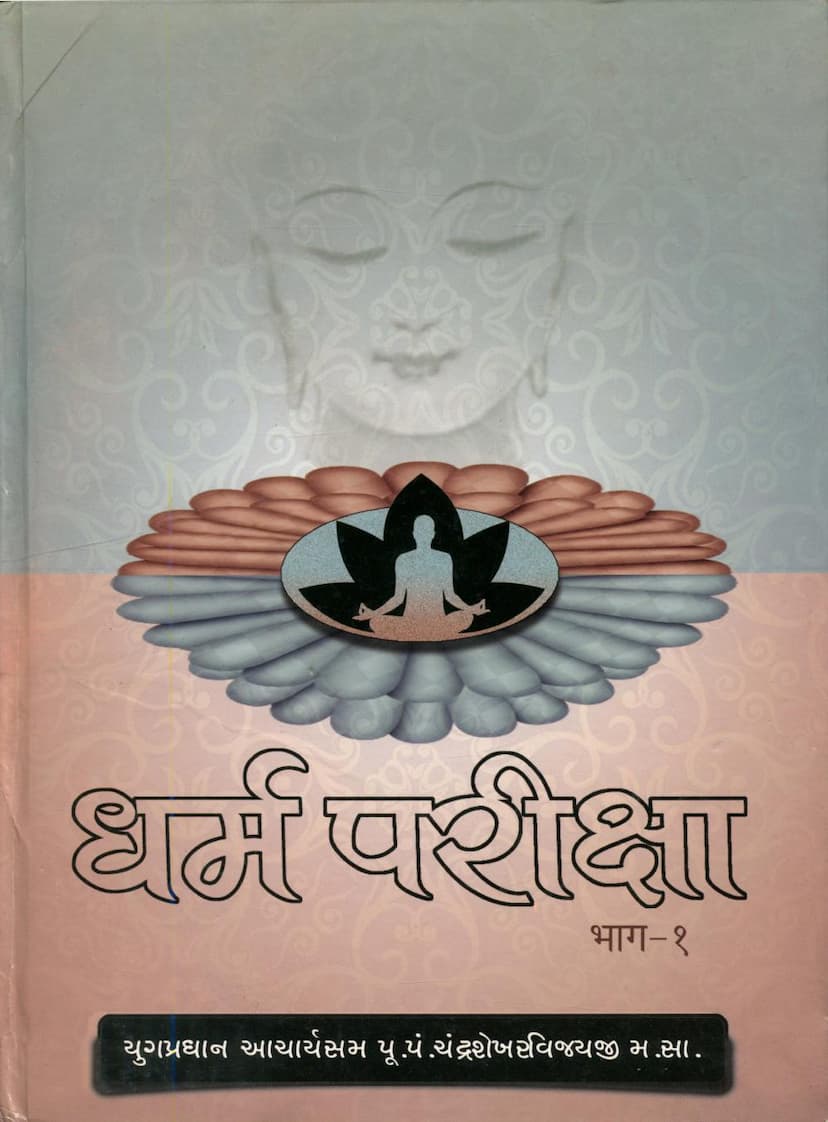Dharm Pariksha Part 01
Added to library: September 1, 2025

Summary
This is a comprehensive summary of the provided Jain text, "Dharm Pariksha Part 01," authored by Chandrashekharvijay and published by Kamal Prakashan Trust.
Book Title: Dharm Pariksha Part 01 (धर्म परीक्षा भाग-१) Author: Acharya Sam P.P. Shri Chandrashekharvijayji M.S. (based on the commentary and translation of the original work) Original Author of Dharm Pariksha: Mahamahopadhyaya Yashovijayji Publisher: Kamal Prakashan Trust
Core Subject of Part 01: The central theme of this first part of "Dharm Pariksha" is the detailed examination of the rule that "those who propound that which is contrary to scripture (utsutra-prarupak) will inevitably have an infinite cycle of rebirth." It delves into whether this is an absolute rule or if there are nuances and exceptions based on the nature of the actions and the underlying consciousness (adhyavasaya).
Purpose of the Commentary: The text is presented with the "Chandrashekheriya Teeka" (commentary) and "Vivechan" (detailed explanation). The primary goal of this commentary, as stated in the preface, is to make the profound and often difficult works of Mahamahopadhyaya Yashovijayji accessible to a wider audience of monks and nuns. Yashovijayji's original work, though invaluable, is challenging due to its complex style, making it difficult for many to study. This commentary aims to simplify the language and clarify the underlying principles.
Key Themes and Arguments Discussed:
-
Yashovijayji's Contribution: The preface highlights Yashovijayji's genius and his ability to preserve and elucidate the profound truths within the Jain Agamas, especially relevant in the current challenging era (Kaliyuga). His works provide deep insights that were previously inaccessible to many.
-
The Nature of "Utsutra-prarupana": The text grapples with the concept of "utsutra-prarupana" – speaking or acting contrary to the established scriptural teachings. It addresses the common belief that any such deviation inevitably leads to infinite suffering in the cycle of rebirths.
-
Challenging the Absolute Rule: The core of this volume is the refutation of the absolute assertion that all utsutra-prarupakas are always condemned to an infinite cycle of rebirths.
- The Argument Against Absolutism: The text, following Yashovijayji, argues that the intensity and nature of the "adhyavasaya" (consciousness, mental state) behind the action are crucial. Depending on whether the adhyavasaya is intense, moderate, or mild, the consequences (cycle of rebirths) can vary.
- Examples and Proof: Yashovijayji uses scriptural examples and logical reasoning to demonstrate that utsutra-prarupakas can indeed achieve liberation (moksha) even within a few lifetimes. This is shown through instances of individuals who may have uttered something contrary to scripture but, due to their underlying mental state and subsequent actions (like penance or atonement), were not bound to an infinite cycle.
-
The Importance of "Madhyasthya" (Equanimity/Neutrality): The text strongly emphasizes "madhyasthya" as the key to correct scriptural examination ("Dharm Pariksha").
- Distinguishing Types of Madhyasthya: It differentiates between two types of madhyasthya: one that is detrimental to examination (e.g., equating valuable things with worthless things) and one that is conducive to examination (e.g., freedom from attachment and aversion, the absence of the fear of losing one's own established beliefs when examining them). The latter is essential for genuine "Dharm Pariksha."
- Madhyasthya and Truth Discovery: Madhyasthya allows one to approach subjects with an open mind, free from preconceived notions or biases, leading to the true understanding of principles.
-
The Role of Intention and Consciousness (Adhyavasaya): The commentary consistently returns to the idea that the internal state and intention behind an action are paramount. Even actions that might appear contrary to scripture can have different outcomes based on the underlying consciousness.
- Intense vs. Mild Adhyavasaya: The text explains that intense negative adhyavasaya (e.g., malicious intent to destroy the true path) leads to more severe consequences, potentially an infinite cycle. However, milder forms of adhyavasaya, or those stemming from ignorance rather than malice, can lead to less severe consequences.
- The Concept of "Anubandha": The continuation and intensity of karmic tendencies ("anubandha") are highlighted as more critical than the mere act of binding karma. Even if an action results in a certain type of karma, its "anubandha" determines the duration and severity of its effects.
-
Critique of Sectarianism: The work implicitly criticizes rigid sectarian views, particularly the idea that only one's own sect (like the Tapagachha) represents the true path, while others are inherently misguided and doomed to infinite suffering. The text aims to show that internal states and adherence to core principles matter more than outward affiliations.
-
Detailed Examination of "Yathachanda" Teachings: A significant portion of the text (indicated by the extensive index) dissects various "yathachanda" (actions that may appear contrary to strict interpretation but are sometimes defended by some followers) to illustrate the points about adhyavasaya, intention, and scriptural interpretation. These examples, though not fully elaborated in this summary, cover a range of practices and discussions within Jain monastic life.
-
Rejection of Absolute Exclusivity: The fundamental message is that Jain philosophy does not subscribe to absolute exclusivity in determining karmic outcomes. The emphasis is on the nuanced understanding of actions, intentions, and the ultimate state of consciousness, rather than a rigid, black-and-white classification.
Conclusion:
"Dharm Pariksha Part 01" is a foundational text that meticulously examines a crucial tenet of Jainism concerning the consequences of deviating from scriptural norms. By presenting the arguments of Mahamahopadhyaya Yashovijayji, interpreted and elaborated by Chandrashekharvijayji, it underscores the critical role of "madhyasthya" and the depth of understanding regarding "adhyavasaya" and "anubandha" in determining one's spiritual journey. The book serves as a guide to discerning the true principles of Jainism, moving beyond rigid interpretations to a more profound appreciation of the multifaceted nature of spiritual practice and its consequences.